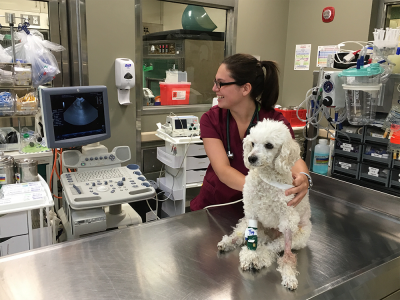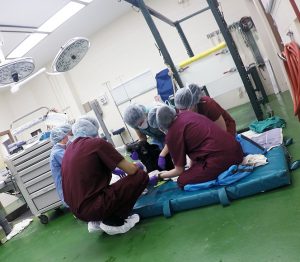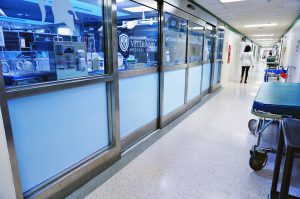
SnowPocalypse 2019 is the most recent and dramatic event in the Midwest. Schools closed, businesses turned off their open signs, and dogs sheltered inside, buried under blankets next to their owners. But what happens when Fluffy, the dog, swallows a raisin? Or, Lightning, the American Quarter horse, becomes colicky? Their owners load them up, strap them in, and drive to the MSU Veterinary Medical Center’s Emergency and Critical Care Medicine Service (ECCM).
Beeeep, beeeep, beeeep. Cah-luck, cah-lack, cuh-luck, cuh-lack. It’s three o’clock in the morning at the MSU Veterinary Medical Center. Two horses with colic, one abdominal trauma patient, and a post-C-section heifer are recovering in the Large Animal Clinic. In the Small Animal Clinic, emergency and critical care veterinarians, licensed veterinary technicians, and veterinary assistants are all over the place; a French Bulldog with anti-freeze poisoning just came in, a geriatric cat with symptoms of kidney failure is being prepped for ultrasound, and a nine-week-old puppy, who can’t stop vomiting, is sitting with their owner in an exam room. This is a typical day in a veterinary trauma center.

Those who work at the MSU ECCM don’t have the luxury of preparing for what kind of case is going to come through the door. The only thing they know for sure is their days are going to be unpredictable; there are no set appointments, patients arrive in varying stages of many illnesses, and there is rarely a dull moment. This setting is even more intense and irregular when they are other things going on, like dangerous weather conditions.
As an emergency and critical care center, MSU ECCM team members often find themselves torn between responsibilities; they may do everything they can to save a pet’s life in one moment and work to comfort a (sometimes high-strung and sleep-deprived) pet owner in the next. They go from communicating the cost of a life-saving procedure to intubating a cat who went into respiratory distress. While doing all that, they must find time to grab a snack, sip some water, update medical records, and maintain their focus.

Since the ECCM is a full-service clinic that is open 24/7/365, they are staffed accordingly in the middle of the night, on holidays, and during school and road closings. So, even though roads were frozen and intense winds caused power outages, MSU emergency veterinarians, veterinary technicians, and support staff have bundled up and shuffled their way into work. SnowPocalypse doesn’t mean the clinic closes; it means it stays open—all day, every day, no matter what—because animal emergencies are never planned. And neither is unfavorable weather (though meteorologists do their best).
Every animal that visits the ECCM is there for the same reason—an emergency. Because of this, patients are triaged when they check in by order of most to least critical. While this may be uncomfortable for animals and their owners, especially when the animal is in pain and the owner is worried, just like in human emergency medicine, the first-come-first-serve practice also doesn’t apply in veterinary medicine. In order to be a veterinary trauma center, members of the emergency veterinary healthcare team must follow a process. This process allows them to see and treat every animal that trots, gallops, or is carried in through their door, regardless of the time of day, date on the calendar, or weather conditions outside.

Dangerous temperatures and ice-slickened roads don’t go away for those who still need to go to work to save the lives of our animals. But these people who are always there for our animals—these life savers, hard-workers, and clinical experts—have lives, too. They pack lunches and drop their kids off at bus stops and kiss their partners goodbye every morning before they leave for work. They have their own animals to love and with which they spend time. They cook the Thanksgiving turkey and decorate the holiday cookies, even if they won’t be home to share the holidays with their loved ones; they will be at the MSU Veterinary Medical Center, ready to draw blood, administer anesthesia, and perform life-saving surgeries.
It's safe to say that these individuals sometimes put their own wellbeing at risk to save our pets' lives. It's important for us to remember how much veterinary health care teams love what they do. They want to be there for us when our furry family members need them most.
